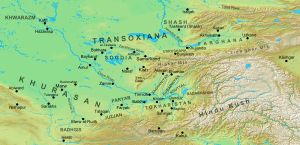Abu Mansur Muhammad
Abu Mansur Muhammad ibn 'Abd al-Razzaq ibn 'Abdallah ibn Farrukh, also known as Ibn 'Abd al-Razzaq, was a Iranian nobleman who served as the governor of Samanid Tus, and also briefly as a general under the Buyids.
Early career
Early service under the Samanids and rebellion

He belonged to a dehqan family from Tus, which claimed descent from a spahbed (army chief), who lived during the lifetime of the Sasanian king Khosrau II. The family further claimed descent from the Pishdadian dynasty. When the Samanid ruler Nasr II (r. 914-943) appointed the Muhtajid prince Abu 'Ali Chaghani as the governor of Khurasan, Abu Mansur ruled Tus on behalf of Abu 'Ali until 945, and then joined his rebellion against Nasr's succesor, Nuh I (r. 943-954). While Abu 'Ali was making expeditions against the Samanids, Abu Mansur was appointed as his commander in Khurasan. Bukhara was shortly captured, and and Nuh's uncle Ibrahim ibn Ahmad crowned himself as the new ruler of the Samanid dynasty. However, in 947, Nuh I managed to recapture Bukhara and have Ibrahim blinded. He was, however, unable to win a decisive battle over Abu 'Ali, who had obtained the support of other Samanid vassals, such as the rulers of Khuttal, and made peace with him instead.
Service under the Buyids
Meanwhile, Abu Mansur fled to the Buyid city of Ray, where he took refuge, and began serving the Buyid ruler Rukn al-Dawla. In 949, he was sent to an expedition to conquer Azerbaijan, which was then controlled by the Dailamite Sallarids. The Sallarid ruler of Dailam, Wahsudan ibn Muhammad, shortly sent an army under the Kurdish general Daisam, but the latter was forced to retreat to Arran. Abu Mansur, however, after having suffered difficulties to conquer Azerbaijan, was forced to retreat back to Ray.
Later service under the Samanids and death

In 950/951, Abu Mansur returned to his native Khurasan, where he was pardoned by Nuh II, and was reappointed as the governor of Tus. He later wanted to create a Shahnameh ("Book of Kings"), and ordered his minister Abu Mansur Mamari to invite several scholars in order to create the book; they created a New Persian version of the Khwaday-Namag in 957, and expanded it with other sources. The book became known as "Shahnama-ye Abu Mansuri" (the book of kings of Abu Mansuri). However, only the introduction of the book remains today. Abu Mansur was later appointed as the commander of Khurasan. 6 months later, however, he was replaced by the Turkic general Alptigin, and shortly returned to Tus. Nuh II later died in 954, and was succeeded by his son Abd al-Malik I. Meanwhile, Turkic officers began increasing their power and influence, thus resulting in instability in the Samanid state. Abd al-Malik later died in a accident in 961, which resulted in a succession crisis; The Turkic faction of Alptigin wanted Abd al-Malik's son as the new Samanid ruler, while another Turkic general named Fa'iq, who was supported by the Iranians, wanted the latter's brother Mansur I as the new Samanid ruler.
Fa'iq eventually managed to emerge victorious, and Alptigin fled to Ghazni, while Mansur I was crowned as the ruler of the Samanids. Abu Mansur was shortly appointed as the commander of Khorasan by Mansur, and was ordered to defeat rebellious Alptigin, which he managed to accomplish, and Alptigin shortly fled to Balkh. However, Abu Mansur shortly changed his allegiance to Rukn al-Dawla, which resulted in the death of Abu Mansur during a battle with the newly appointed commander of Khurasan, Abu'l-Hasan Muhammad ibn Ibrahim. Abu Mansur was survived by his two sons, Abdallah 'Abd al-Razzaq, and Mansur 'Abd al-Razzaq.
References
Sources
- Khalegi-Motlagh, Dj. (1983). "ABŪ MANṢŪR MAʿMARĪ". Encyclopaedia Iranica, Vol. I, Fasc. 4. p. 337.
{{cite encyclopedia}}: Invalid|ref=harv(help) - Frye, R.N. (1975). "The Sāmānids". In Frye, R.N. (ed.). The Cambridge History of Iran, Volume 4: From the Arab Invasion to the Saljuqs. Cambridge: Cambridge University Press. pp. 136–161. ISBN 0-521-20093-8.
- Khalegi-Motlagh, Dj. (1983). "ABŪ MANṢŪR ʿABD-AL-RAZZĀQ". Encyclopaedia Iranica, Vol. I, Fasc. 3. p. 335.
{{cite encyclopedia}}: Invalid|ref=harv(help)
